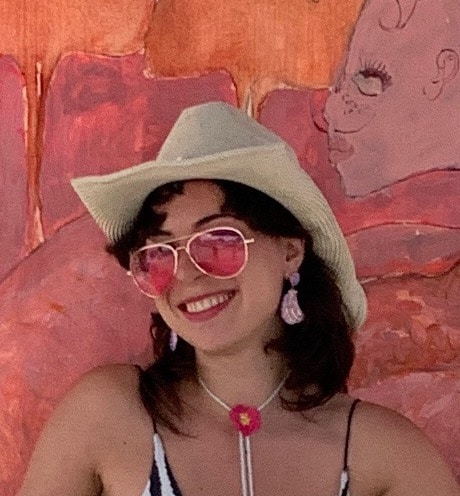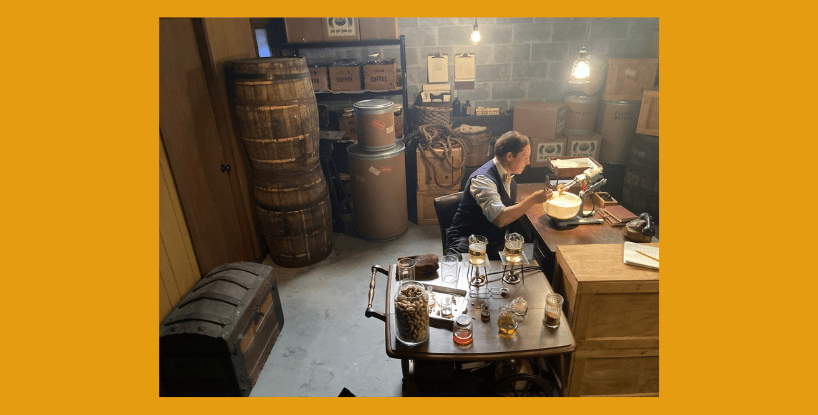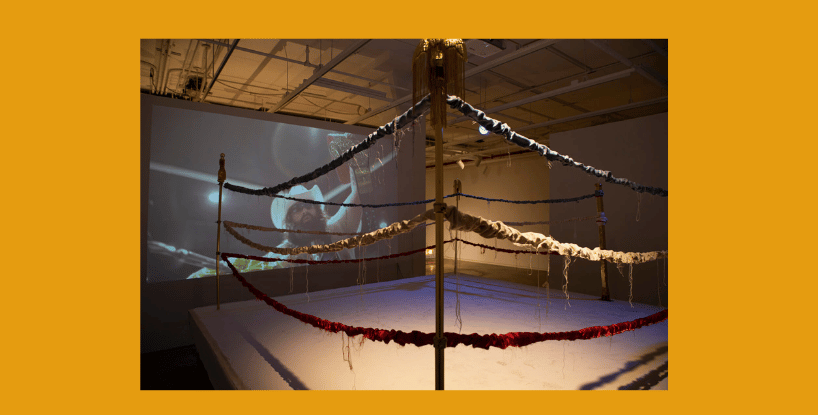Production Designer Jessica Ellis

In The Crew Chronicles, we interview Cubers to learn about their Path to the Craft, Tools of the Trade, Today's Film Industry, with a Round of Revealing Quickies.

Jessica Ellis, Spills the Tea on Production Design vs. Set Design Period Piece Research, AI and
During an impressive thunderstorm, I spoke with NYC and LA-based Production Designer, Art Director, and Studio Artist Jessica Ellis about Production Design vs. Art Direction, AI in Filmmaking, and how she brought one-hundred-and-twenty period sets to life in a single television season.
Plus, set scores, and the implications of being mysteriously good at the board game Clue.
PATH TO THE CRAFT
Q: What is your specialty in the Art Department?
I design and I art direct. I’ve been doing a lot more art directing lately, but right now, my specialty is period piece set design — a lot of History Channel stuff. It’s a lot of research-based and then re-creation work.
But eventually, I’d like to get more into experimental type work. I’d love to work more with narratives and character building and set design, where you’re more in touch with the script, and you’re really reading the script as a piece of art — rather than a lot of the work.
In what I’m doing right now, the script is more of a prescription than it is a piece of art that you’re bonding with and experiencing because it’s History Channel. So you’re really getting a lot of sets out there. It’s like 120 builds per season.
Q: Are you more of a Production Designer, Set Designer, or both?
I call myself a Production Designer because that’s mostly what I’m interested in doing. Although I have been doing a lot of Art Directing. So, I would say I’m both.
When I design, I am able to lean more into the creative side of things and really make those aesthetic decisions.
Whereas I view my job as Art Director as more of the person who makes things happen. I’m facilitating the Designer’s wants and needs, and asking, how practical is this? And looking for labor and the whole crew. It’s a little bit more left-brained, whereas I consider myself to be way more of a right-brained person.
I’d like to do less of the “making it happen” type brain, and lean more into the creative choices.
But ultimately, even when you’re Art Directing, you’re lucky enough to make a lot of creative choices as well. There’s a creative element in understanding what the designer’s intentions are and understanding their creative language. They’re not always going to be around every single time you have a small question, so you have to fully embody their intention.
Q: Tell me a little bit about how you got into Production Design. What were there early childhood warning signs?
I was always rearranging my room. It’s something I still do now.
Being a New Yorker, you’re always given these weird spaces that, you know, you can afford your apartment, but there’s, like, a bathtub in the living room. You’re always trying to navigate these sorts of problematic spaces. I do have a natural inclination of understanding space and design, but I think one of the biggest parallels for me is that my background is in painting.
PERIOD PIECE SET DESIGN

Q: I’m curious about the History Channel shows. Each one has over 100 different period sets! How on earth do you go about period piece set design?
I designed one show and then another History show, during the summer, and that was over 100 sets. Immediately after that show, I Art Directed one that had 120 sets. And, from the Art Director’s perspective, and handling that logistically, it’s a lot of mapping out time and strategically planning, and doing things like staggering crew times.
It’s a very fine balance of knowing where to be able to push, because there’s trust, too. There’s a trust with the Production Designer, there’s a trust with the Director, where you can say, “We can’t do it. We have to scale it back an extreme amount.” But if you do that too much, you lose that trust.
Q: Speak to the Period Set Design Process. Do they give you the scrip and say, “We need an 1800s kitchen. Go?”
Well, there’s a lot of people. For the one that’s released now, the Food That Built America, I am one part of the machinery in a big factory. We have the Production Designer, the Assistant Art Director, Set Dec, Props — there’s so many people that are part of this. So the first thing you would do in that situation is figure out where to delegate what, and then interpret the script.

"So, actually, I kind of owe my career to ArtCube, which is amazing. It's a funny plug to put in there, but it’s true."
Q: Tell us a little bit more about period piece Art Direction and historical research of props and set decoration.
So every department is researching that, and every department is responsible for delivering accurate materials.
Props has to do a really intense amount of research. For set dec, there’s a little bit more flexibility there, whereas for props there’s so much more spotlight on one object. But yeah, pretty much the entire department has to be researching the time period and the script and sort of cross-checking each other.
And a lot of it is instinct, too. The nice thing is the more period pieces you do, the less research you really have to do. And so you’re like, “Oh, yeah, I know that’s 1970’s.” And, “No, they wouldn’t have that until the 1920s.”
And so it does get easier, but it’s so specific that you always have to research. It’s like, oh, what did they have in Wisconsin in 1930? They would have had something different in New York in 1930, but Wisconsin could be different. How do you figure that out?
Q: How did you get into the film industry?
I fell into production by accident. I was just looking for work as an artist. And I picked up a PA job from ArtCube doing returns for a feature and it was a terrible gig, terrible pay, whatever, but it was my first gig, so I took it.
But that Production Designer is actually the person who brought me up through the ranks as the Set Dresser. And then when you’re going to be a Set Decorator for the first time, that’s not a job you can just go apply for green. Someone has to trust you and take you through it.
Q: How do you use ArtCube? Has it helped you in your work?
"I think one of the biggest ways I use ArtCube is when I'm hiring Art Department crew.
Really great people that I work with again and again and again. And I honestly don't know what my career would look like without ArtCube."

Q: How has the WGA Strike been affecting you? And how afraid of AI are you right now in your specific line of work?
You know, it’s been okay. It’s been different. There’s a lot less long-form stuff coming my way. But then I have been doing a lot more commercial work, which, honestly, I could totally get used to. It’s nice. You work a lot less and you make the same amount of money.
I really have nothing against commercials. I love doing commercials, and it’s a much more sustainable life. So, yes, I’m affected, but I’m actually kind of liking it, too.
Q: What about AI and filmmaking?
I understand where the writers are coming from, because it could replace them. I use AI — I’m actually using it a lot in my studio practice now. And it is missing the human element. Like, it can write something really well, but I really don’t see a world where movies could actually be written by a program like that, because it doesn’t have nuances, right?
I don’t think that AI could ever fully replicate really good writing or, really good art-making. And I’m in a sort of an optimistic view of it where I think and hope that it could just be a really good resource. I see a lot of ways, even in the rt department, it could really help. Like, we’re still going to hire a graphic designer, because we need someone to generate the AI.
Even if we start using AI instead. Right? So, the graphic designers still have a job, in my department, at least. So I think that for our department, it actually could be a really great resource and not take away jobs.
It can be used in green screening, right? And putting in AI-generated backgrounds. Somebody told me something a while ago, and I absolutely love thinking sets this way. I said something like, oh, it really sucks that that wasn’t even in the frame and they never saw that whole section we dressed. And somebody said to me,
"You're not just making the set for camera, you're making the set for talent. You're making the set for the director. The whole shooting crew. You're making an environment."I recently started working with a Production Designer who will put little things in drawers. So if they want to improv in action, they actually do feel like they’re in their home — that they’re in this character’s home.
And so AI can’t do that, right? If you’re going to have people who are acting in front of a green screen and then the set is AI generated afterward, it would deeply affect the performance.
So I understand how other people could be worried about it, but I think for our department, it could just be a good resource, fortunately.
QUICKIES

Q: What is your favorite score from the set?
Probably this chair. And then also there’s another chair behind me. That one. Yeah. I love both of my brown leather chairs.
Q: What is something that you are weirdly good at?
I’m good at winning Clue.
So my friends and I had this game night a couple of months ago, and I won like six games of Clue in a row.
This is where it gets a little woo-woo. I can also read people’s minds a little bit. I think I’m an empath. I can sort of tell what people are thinking, and that’s actually how I won at Clue; it was just going with my intuitive guess and being like, it was.”Mrs. Peacock with the knife in the ballroom.”
“I’m good at interpersonal perception, which is the bigger theme here.”

Work with Jessica
Jessica Ellis
Jessica Ellis is an L.A. & N.Y.C. based production designer, art director and multi-disciplinary artist. Her work includes well known commercial brands, major network television shows and feature films.




